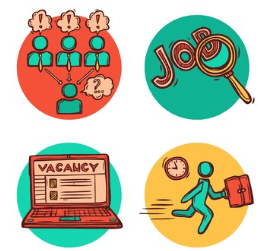76% of hiring managers admit attracting the right job candidates is their greatest challenge.
73% of job seekers say the process of looking for a job is one of the most stressful events in life.
60% of candidates have quit a job application process midway because of its length and complexity.
Statistics like these are a testament to how important the recruitment journey is for employers as well as the candidates. For candidates, finding a job that is perfect for them is a long and tedious process. On the other hand, for recruiters and companies, it impacts their resources and existing workforce.

Ensuring a smooth recruitment journey is great for the candidates. It is also beneficial for the company. How to ensure a smooth recruitment journey begins with understanding what the candidate recruitment journey is, why is it important and how it benefits an organisation.
What Is a Candidate Recruitment Journey?
As a company, you sell a product or a service and you have customers that go through a purchasing journey before they decide to buy from you. It begins long before they first interact with you. A candidate’s hiring journey is very similar to that of a customer. Before a candidate applies for a position at your company, they thoroughly research you, check your online employee reviews and base their decision on factors that are important to them.
Essentially, it is the journey a candidate experiences while they’re looking for a job. For a candidate, this journey begins long before their first interaction with a company and it only comes to an end when the organisation makes the hiring decision and they either accept or reject the job offer.
The major touchpoints of a candidate’s journey that you can influence are:
- Job ads/promotions
- Career site
- Company social media pages
- Career fares
- Job applications – online or offline
- Communication during and after the application
- Feedback after the application

Each one of these touchpoints plays a crucial role towards the final decision of whether or not the candidate will choose to work in your organisation and a positive experience at each stage not only contributes to that decision but also builds your employer brand. There is more to creating a positive experience for candidates during the recruitment process.
Why Is It Important To Ensure A Positive Candidate Experience?
The fact that 60% of job seekers have had a bad experience during hiring says a lot about how long-drawn the hiring process is and how tedious it can be. A lot of companies begin the hiring process without truly understanding the candidates who are on the receiving end of the vacancy notice.
When you’re starting the hiring process for any position, think about the basics of how it will be perceived. Asking some basic questions will help you understand this better.
- How will your vacancy or ad be displayed?
- How will it reach the candidate?
- How will they respond to the ad or vacancy notice?
- What part of the ad will the candidate focus on?
- What information about your company will the candidate look for? Where will they look for it?
- What reputation and reviews of the company will they come across?
- How will they perceive the organisation?

The answers to these questions will enable you to create a better experience for the candidates. The hiring experience that a candidate goes through with your organisation directly affects your employer brand. 80% of candidates who experience an unsatisfactory recruitment process revealed that they openly tell people about their experience, and a third of these candidates will do so proactively.
These candidates will either become a part of your workforce or go out into the world and speak of their experience with you. However, there is another side to creating a pleasant candidate experience. Organizations that invest in a strong candidate experience improve the quality of their new hires by 70%.
There are stages of the journey that you can work to improve.
Stages Of Candidate Journey
As discussed earlier, you can think of a candidate’s recruitment journey like that of a customer journey. It’s almost like a sales funnel with different stages. The six stages of a candidate’s journey are Awareness, Deliberation, Interest, Application, Selection, and Hiring Decision.
The first three of these six stages – awareness, deliberation and interest have a lot to do with marketing while the last three – application, selection and hiring decision typically belong to the recruitment process.

Dividing the recruitment process into these stages allows you to track the candidate journey and better the experience which in turn benefits you.
How To Ensure A Smooth Candidate Recruitment Journey?
It is established that the candidate’s journey is important. So, what can you do to improve the candidate experience? Here are a few things that will help you create a significantly better experience for the candidates that apply to work for your organisation.
Candidate must be at the centre of the hiring process
At every stage of the hiring journey, you need to make sure that the candidate is at the centre of the process otherwise you risk alienating the candidates. Focus on what the candidates need and what their overall experience will be when they apply for a position with your organisation. The goal of creating a candidate-centric journey is not just to offer a great experience for the candidates. It also allows you to build the foundation for long-term relationships with the candidates which means they will continue to interact with the company regardless of whether or not they end up getting hired.
A short, engaging and simple application process that gives the candidates a realistic insight into your organisation makes for an ideal recruitment process.

The crucial pre-application stage
Contrary to popular belief, a candidate’s journey with your company starts long before they begin to interact with you. In fact, for 86% of job seekers, the decision to apply for a company depends on the reviews and ratings they find online.
What candidates see about your company before they apply goes a long way toward whether or not they will join you. A candidate’s journey with you begins the moment they come across one of your touchpoints. It could be an ad, a company review, an email, the career page of your website, or any one of the other touchpoints mentioned earlier. A positive impression through any of these touchpoints has the potential to turn a viable candidate into a potential job seeker. This is where a strong employer brand comes in handy.
Needs of the candidate
Hiring is a lot more than simply filling a vacant position in your company. It’s about finding the right fit for your company and from the candidate’s perspective, it’s about finding the ideal job.
Identifying a candidate’s needs and what they want from a job is a great way to engage with them. Maslow’s Hierarchy of Needs can help you with this. Physiological needs are the most basic and once they’re fulfilled, the candidate moves up to levels like safety & security, a sense of belonging, a sense of accomplishment and finally self-actualisation.
The questions you need to answer are – how your job offer fits into the candidate’s life? How does the position feature in the candidate’s career goals? Which of these needs can you fulfill?
Communicating the answer to these questions early on paves the way to creating a smooth candidate journey.

Go through the application process
Oftentimes, when you create a process, you are so closely involved in it that you don’t truly understand its simplicity or complexity of it. You need to get an objective point of view to understand what exactly the candidates go through when they apply for a job with you.
The best way to do this is to go through the application process yourself. Look for things like, are there too many questions? Is the application process mobile friendly? Is it easy to upload the necessary documents? How many steps does the application have?
The simpler the application process, the more candidates you will have to choose from.
Remove the unnecessary fields from the application to minimize the amount of time it takes to fill out the application. You can also speed up the application by letting the candidate steer their application. Allow them to self-schedule interviews as per the recruiting manager’s availability. This cuts down on the time and effort spent on back-and-forth emails.
Customise and chart the ideal candidate journey
Unless you are clear about the journey you want the candidates to go through, you will never be able to create a smooth process for them to follow. Chart out the entire candidate journey visually to understand each step. This will give you great insight into each touchpoint of the journey as well as enable you to understand candidate behaviour at each of the steps.
For example, a candidate may communicate extremely well during an interview but their skill in written communication is lacking. Charting out the journey will allow you to assess the candidate’s strengths and weaknesses at each step, thereby giving you an understanding of how well they fit into your organisation.

Offer clarity about the organisation
Candidates are curious about what it’s like to work at any organisation. This is the reason they go digging through company websites and social media pages. They want to know what the culture of a company is and what they can expect should they choose to join. Every candidate tries to envision themselves as part of the company and if somewhere they feel, it’s not the right fit, they probably won’t apply for the position.
Offering a thorough understanding of their day-to-day activities and responsibilities will go a long way toward the candidate coming to a decision. Use culture videos and employee testimonials to provide candidates with this information.
Communicate throughout the process
One of the biggest challenges that candidates face is the lack of communication from recruiters.
Sending out a simple email with an acknowledgement and a description of the next steps is enough to keep the candidates engaged. This will also keep your recruitment team accountable to respond within a given period of time.
Simple communication after every step of the hiring process keeps the candidate involved and gives them clarity on where they stand and what is expected of them next.

Pre-boarding
You have to know that this journey does not end with you extending an offer and the candidate accepting it. The hiring journey must also involve pre-boarding which is the stage between a candidate accepting the job offer and joining the company. It could span from a few days to a couple of months, depending on their notice period.
This is the time to get the candidate excited about working for your company. It lays the foundation for a strong relationship with the new employee and builds a sense of loyalty. You can share material about the company, the benefits of working there and emails about the work culture at regular intervals to keep the new hire involved and excited.
The days of reading through resumes and walk-in interviews are long gone. Recruiters now need to focus on what the candidates need and go beyond the monetary value of a job. In this day and age, candidates are looking for the full package and a smooth recruitment journey is where it all starts.







